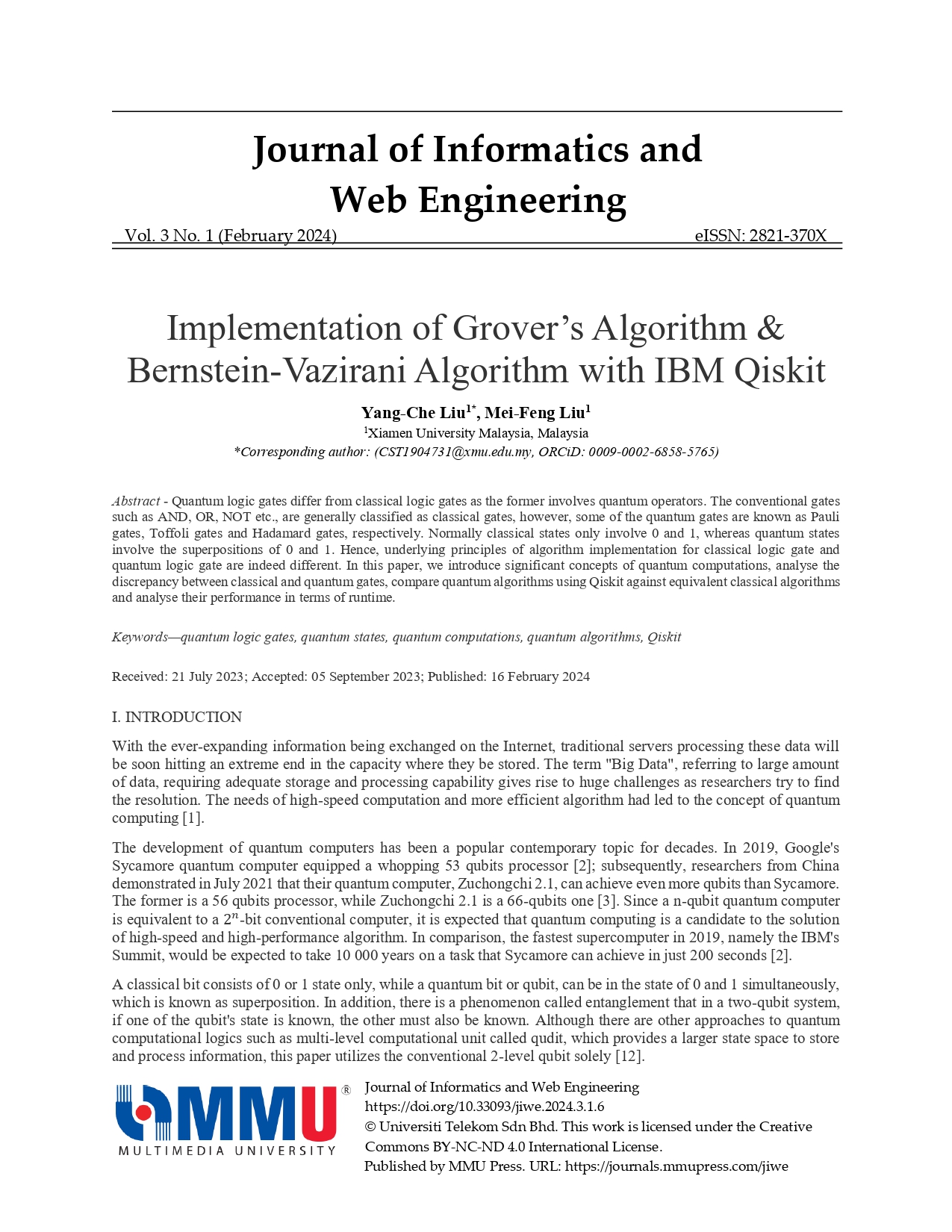Implementation of Grover’s Algorithm & Bernstein-Vazirani Algorithm with IBM Qiskit
Main Article Content
Abstract
Quantum logic gates differ from classical logic gates as the former involves quantum operators. The conventional gates such as AND, OR, NOT etc., are generally classified as classical gates, however, some of the quantum gates are known as Pauli gates, Toffoli gates and Hadamard gates, respectively. Normally classical states only involve 0 and 1, whereas quantum states involve the superpositions of 0 and 1. Hence, underlying principles of algorithm implementation for classical logic gate and quantum logic gate are indeed different. In this paper, we introduce significant concepts of quantum computations, analyse the discrepancy between classical and quantum gates, compare quantum algorithms using Qiskit against equivalent classical algorithms and analyse their performance in terms of runtime.
Article Details

This work is licensed under a Creative Commons Attribution-NonCommercial-NoDerivatives 4.0 International License.
All articles published in JIWE are licensed under a Creative Commons Attribution-NonCommercial-NoDerivatives 4.0 International (CC BY-NC-ND 4.0) License. Readers are allowed to
- Share — copy and redistribute the material in any medium or format under the following conditions:
- Attribution — You must give appropriate credit, provide a link to the license, and indicate if changes were made. You may do so in any reasonable manner, but not in any way that suggests the licensor endorses you or your use;
- NonCommercial — You may not use the material for commercial purposes;
- NoDerivatives — If you remix, transform, or build upon the material, you may not distribute the modified material.
References
P. Abhishek, and V. Ramesh, "Quantum computing for big data analysis", Indian Journal of Science, 2015, 14(43), pp. 98-104.
A. Frank, A. Kunal, B. Ryan, B. Dave, B. C. Joseph, et al. "Quantum supremacy using a programmable superconducting processor", Nature 574, 2019, pp. 505 - 51.
Y. Wu, W.-S. Bao, S. Cao, F. Chen, M.-C. Chen, et al. "Strong quantum computational advantage using a superconducting quantum processor", Physical Review Letters, 2019, 127(18).
V. Chamola, A. Jolfaei, V. Chanana, P. Parashari, and V. Hassija, “Information security in the Post Quantum era for 5G and beyond networks: Threats to existing cryptography, and post-quantum cryptography,” Computer Communications, vol. 176, pp. 99–118, 2021.
G. Acampora, and A. Vitiello, "Implementing evolutionary optimization on actual quantum processors." Information Sciences, 2021, 575, pp. 542–562.
H. Soeparno, and A. S. Perbangsa, "Cloud quantum computing concept and development: A systematic literature review." Procedia Computer Science, 2021, 179, pp. 944–954.
L. Gyongyosi, and S. Imre, "A survey on quantum computing technology." Computer Science Review, 2019, 31, 51–71.
G. A. Nemnes and D. Dragoman, “Reconfigurable quantum logic gates using Rashba controlled spin polarized currents,” Physica E: Low-dimensional Systems and Nanostructures, vol. 111, pp. 13–19, 2019.
A. Pourkia and J. Batle, “Cyclic groups and quantum logic gates,” Annals of Physics, vol. 373, pp. 10–27, 2016.
H. M. Gaur, A. K. Singh, and U. Ghanekar, “In-depth comparative analysis of reversible gates for designing logic circuits,” Procedia Computer Science, vol. 125, pp. 810–817, 2018.
R. M. Abdullah, R. Basher, A. A. Alwan, and A. Z. Abualkishik, “Quantum Computers for optimization the performance,” Procedia Computer Science, vol. 160, pp. 54–60, 2019.
M. L. Dalla Chiara, R. Giuntini, G. Sergioli, and R. Leporini, “A many-valued approach to quantum computational logics,” Fuzzy Sets and Systems, vol. 335, pp. 94–111, 2018.
E. Bäumer, “Qubits and Quantum States, Quantum Circuits, Measurements - Part 1,” in 1. Qubits and Quantum States, Quantum Circuits, Measurements - Part 1, 2021
E. Bäumer, “Qubits and Quantum States, Quantum Circuits, Measurements - Part 2,” in 2. Qubits and Quantum States, Quantum Circuits, Measurements - Part 2, 2021
E. Bäumer, “ Qubits and Quantum States, Quantum Circuits, Measurements - Part 3,” in 3. Qubits and Quantum States, Quantum Circuits, Measurements - Part 3, 2021
C. de Ronde, The (Quantum) Measurement Problem in Classical Mechanics , 2020.
R. G. Littlejohn, “The Mathematical Formalism of Quantum Mechanics,” 2020
L. Vaidman, “Derivations of the born rule,” Jerusalem Studies in Philosophy and History of Science, pp. 567–584, 2020. doi:10.1007/978-3-030-34316-3_26
S. Aaronson, “Doing my oracle duty,” Shtetl-Optimized, https://scottaaronson.blog/?p=451 (accessed Jul. 15, 2023).
A. J. Daley et al., “Practical quantum advantage in quantum simulation,” Nature, vol. 607, no. 7920, pp. 667–676, 2022. doi:10.1038/s41586-022-04940-6
M. Schuld and N. Killoran, “Is quantum advantage the right goal for quantum machine learning?,” PRX Quantum, vol. 3, no. 3, 2022. doi:10.1103/prxquantum.3.030101
M. Cerezo, G. Verdon, H.-Y. Huang, L. Cincio, and P. J. Coles, “Challenges and opportunities in quantum machine learning,” Nature Computational Science, vol. 2, no. 9, pp. 567–576, 2022. doi:10.1038/s43588-022-00311-3
C. W. Bauer et al., “Quantum simulation for high-energy physics,” PRX Quantum, vol. 4, no. 2, 2023. doi:10.1103/prxquantum.4.027001

